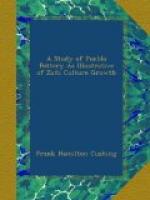[Illustration: a. Modern Moki rain
symbol.
b.
Enlarged decoration of “medicine-jar.”
FIG.
557.—Decoration of ancient medicine-jar
compared
with
rain symbol of modern Moki totem.]
Thus, upon all sacred vessels, from the drums of the esoteric medicine societies of the priesthood and all vases pertaining to them to the keramic appurtenances of the sacred dance or Ka’ ka, all decorations were intentionally emblematic. Of this numerous class of vessels, I will choose but one for illustration—the prayer-meal-bowl of the Ka’ ka. In this, both form and ornamentation are significant. (See Fig. 558.) In explaining how the form of this vessel is held to be symbolic I will quote a passage from the “creation myth” as I rendered it in an article on the origin of corn, belonging to a series on “Zuni Breadstuff,” published this year in the “Millstone” of Indianapolis, Indiana. “Is not the bowl the emblem of the earth, our mother? For from her we draw both food and drink, as a babe draws nourishment from the breast of its mother; and round, as is the rim of a bowl, so is the horizon, terraced with mountains whence rise the clouds.” This alludes to a medicine bowl, not to one of the handled kind, but I will apply it as far as it goes to the latter. The two terraces on either side of the handle (Fig. 558, a a) are in representation of the “ancient sacred place of the spaces,” the handle being the line of the sky, and sometimes painted with the rainbow figure. Now the decorations are a trifle more complex. We may readily perceive that they represent tadpoles (Fig. 558, b b), dragonflies (Fig: 558, c c), with also the frog or toad (Fig. 558); all this is of easy interpretation. As the tadpole frequents the pools of spring time he has been adopted as the symbol of spring rains; the dragon-fly hovers over pools in summer, hence typifies the rains of summer; and the frog, maturing in them later, symbolizes the rains of the later seasons; for all these pools are due to rain fall. When, sometimes, the figure of the sacred butterfly (see Fig. 559, a b) replaces that of the dragon-fly, or alternates with it, it symbolizes the beneficence of summer; since, by a reverse order of reasoning, the Zunis think that the butterflies and migratory birds (see Fig. 560) bring the warm season from the “Land of everlasting summer.”
[Illustration: FIG. 558.—Zuni prayer-meal-bowl.]
Upon vessels of special function, like these we have just noticed, peculiar figures may be regarded as emblematic; on other classes, no matter how evidently conventional and expressive decorations may seem, excepting always, totemic designs, it is wise to use great caution in their interpretation as intentional and not merely imitative.
A general examination, even of the most modern of Pueblo pottery, shows us that certain types of decoration have once been confined to certain types of vessels, all which has its due signification but an examination of which would properly form the subject of another essay.




